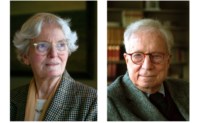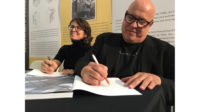On June 18, the national board of directors of the American Institute of Architects (AIA) voted to allow the national AIA Gold Medal to be awarded to two individuals. The amendment was voted on at a meeting at the national AIA convention in Denver. The updated rule goes into effect on January 1, 2014.

The New York chapter of the AIA spearheaded the initiative to overturn the rules governing the awarding of the Gold Medal. Prior to yesterday's vote, the medal could only go to an individual—though if you read the fine print, that individual does not have to be an architect or an American. (He or she could even be dead.)
Jill N. Lerner, FAIA, current president of the New York chapter and a principal at Kohn Pedersen Fox, sent letters to colleagues around the country urging their support of a recommendation that the AIA amend the rules to permit the Gold Medal to be awarded to two individuals practicing together, “but only if their collaborative efforts over time are recognized as having created a singular body of distinguished architectural work.” The wording was intended to distinguish the Gold Medal clearly from the AIA Firm Award. Several other AIA chapters, including San Francisco's, had expressed support for such a rule change.
“The New York delegation worked really hard behind the scenes to make sure that we had all the votes going in,” Lerner told RECORD on Wednesday. Lerner was inspired to promote a change in the Gold Medal rules after two Harvard Graduate School of Design students—Arielle Assouline-Lichten and Caroline James—launched a petition in March to award Denise Scott Brown the Pritzker Prize that excluded her when her professional partner and husband, Robert Venturi, won the prize in 1991. That petition has received thousands of signatures and has helped ignite a growing movement to examine the role of women in the profession.
“As the president of the largest chapter, I felt it was important for us to take the leading role in seeing this get accomplished,” said Lerner. “We got huge amounts of support from many chapters across the country.” She added that George H. Miller, FAIA, a partner at Pei Cobb Freed & Partners and a former president of the AIA, as well as architect Frederic Schwartz, were instrumental in garnering support for the initiative.
Lerner, along with Miller, outlined the proposal at a lunch in New York City on June 4 honoring Scott Brown. Scott Brown said that she and Venturi had jointly submitted for the AIA Gold Medal four times, but their submission had always been returned because it was for both of them. “The ping-pong of ideas over the drawing board, or whatever you use, is a very creative thing,” said Scott Brown, describing the “joy” of collaboration. She added, “I have had ecstasy as an architect, without the Pritzker, without the Gold Medal. I have had a wonderful time, and I have my own respect for myself.”
When contacted after the Gold Medal vote, Scott Brown said, “I’m very, very happy about this and I think it is going to be a kind of datum line. I think that this is the beginning of a big change in architecture.” She says the AIA vote is part of a burgeoning movement, sparked by the Pritzker petition, to understand and celebrate collaboration.
The speed at which the Gold Medal initiative was put forth and then voted on serves as a contrast to the Pritzker Prize jury's response to the petition. Finally, on June 14, jury chair Lord Peter Palumbo responded with a letter stating that the jury would not grant Scott Brown a retroactive prize.
“There were members who said, ‘why so fast, let’s take time,’” Lerner said of the Gold Medal rule change. “It was important to do it now. It’s been long enough.” The AIA is in the midst of a repositioning effort, in part to show that it is nimble and relevant, said Lerner. “Certainly recognition of a partnership where it’s a joint effort to produce a single product is fundamental to being able to recognize all members appropriately—men and women partnerships, and others.”








Post a comment to this article
Report Abusive Comment